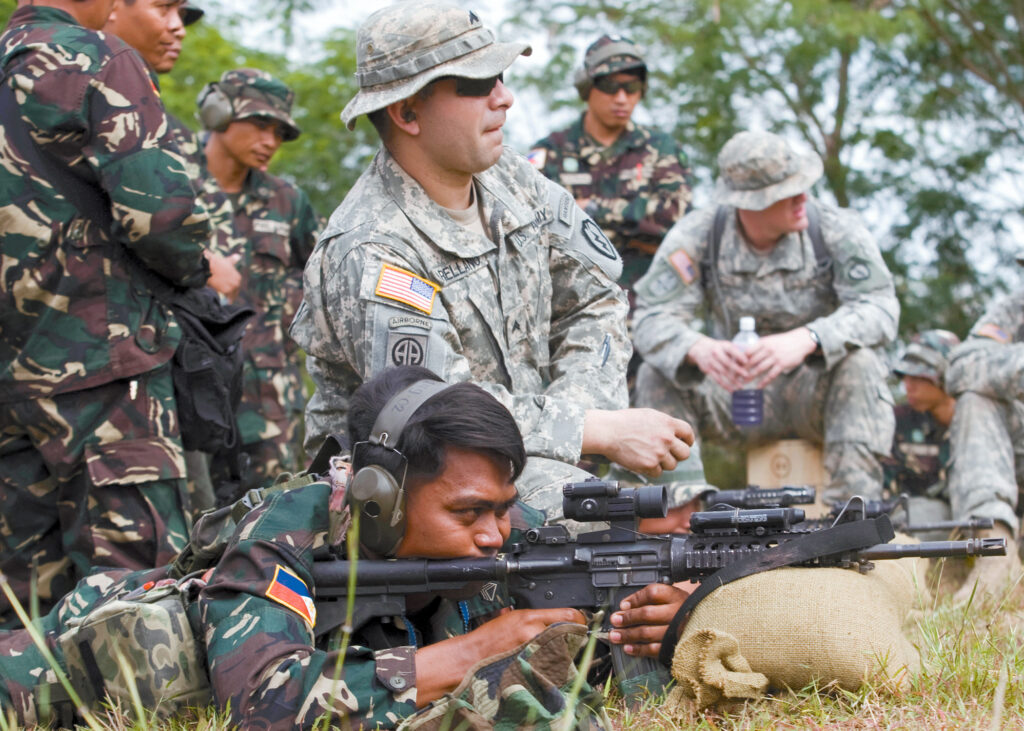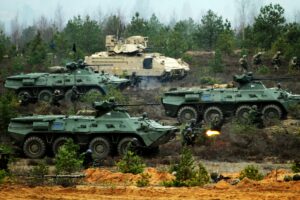By SYDNEY J. FREEDBERG JR.

WASHINGTON: A new paper from the Army chief of staff makes the case for the service’s role in great power competition short of war with Russia and China — from dueling tweets about a humanitarian-relief operation to major military deployments.
Gen. James McConville also does the joint world an intellectual service, because his paper makes it clear that open war itself is only one more kind of competition, not something set apart from it. That’s a major break with the vaunted 2018 National Defense Strategy, which defined “competition” as purely competition short of war and “conflict” as purely open, armed conflict – a distinction that has more to do with US law than how Beijing and Moscow actually operate.
For an official Army document to dare differ from Pentagon strategy, even on a matter of nuance, is surprising. What’s also surprising is how well-written and insightful The Army in Military Competition: Chief of Staff Paper #2 can be, for an official Army document. (We dissected the chief’s Paper #1, on multi-domain operations, last week).
The 2018 strategy sounded a call to arms on “great power competition” but begged the question of what it was, the new Army paper effectively admits. “The 2018 National Defense Strategy focused the Department of Defense on great power competition. There is a lack of consensus, however, regarding how that broad concept is translated to action,” Gen. McConville’s paper says drily. “Soldiers engaged in partnership activities, exercises, and other forms of forward presence indicate they sometimes have difficulty in describing the precise mechanism by which their actions translate to successful competition at the national level.”
The new Army paper aims to fill that gap, even including a detailed appendix of potential actions and their effects. But it also acknowledges the multi-faceted and often murky nature of what many experts call the “grey zone” between true peace and open war.
Russia’s “Little Green Men” In Ukraine

“I want all readers to understand that military competition is an ‘infinite game,’” McConville writes in his preface, echoing former Army Secretary Ryan McCarthy. “We can define winning in competition in many ways: deterring conflict, upholding our interests, remaining the security partner of choice, keeping allies and partners free from coercion and subversion, and discouraging adversaries from malign actions because they know that these acts will not succeed. What we must remember is a win today is an opening for new competition activities tomorrow.”
Benefits of Security Automation are known in commercial software segments and DoD security teams are beginning to realize it as well.
In other words, you can’t declare victory and put an end to competition: It goes on forever. You also can’t pin “competition” down to just one thing:
“Military activities during competition can be either defensive or offensive; lethal or non- lethal; unilateral or multilateral; employ conventional, irregular, and special operations forces from each of the military services in multiple domains,” the paper says (emphasis ours). “Armed conflict is one element of … the competition continuum” – which includes even “general state conflict.”
In other words: War is just another form of competition, albeit a particularly lethal one, and the distinction from other forms is more in our minds and legal frameworks in reality.
The paper attempts to pin this protean concept to the wall by defining three aspects of competition: narrative, direct and indirect. The trifecta doesn’t quite work, but it’s a starting point:
Narrative competition is the constant worldwide struggle for the hearts and minds of a myriad of different audiences in different nations. It’s the fight o tell America’s story and burnish its reputation when adversaries are trying to smear and misinform. Everything the Army does that isn’t secret contributes to the national reputation for good or ill, the paper emphasizes. Insensitive or unethical acts that accomplish the mission today might do lasting reputational damage that every other unit has to deal with down the road.
Direct and indirect competition are defined, bluntly, by whether the US is willing to escalate to the use of armed force or not. In essence, “direct” competition is any case where policymakers are willing to consider American troops killing foreigners. In the paper’s words: “Put simply, it is an issue worth fighting over.” Indirect competition, by contrast, means US use of lethal force is not on the table – although open fighting by allies, partners, and proxies is definitely an option here. Thus providing Stinger missiles to the Afghan rebels against the Soviets was indirect conflict, even though people died, while deploying a combat brigade to a threatened ally’s territory is direct conflict, because the potential is there for a clash between US and foreign forces.
Of course, there’s also constant direct competition for roles, missions, and funding among the US armed forces themselves, and this paper is an indirect argument for the Army’s relevance. True, it never deprecates the other services or exalts the land domain above all others. But its case studies and examples repeatedly describe things the Army does well, or does more than any other service. Those range from delivery of humanitarian aid – the Army handles land transport and supports all joint logistics; to the arming, training, and advising of friendly nations – where ground troops are the dominant service in most countries; to the positioning of heavy combat forces to deter a war or win one.
It’s crucial to have options at all levels, the paper emphasizes, because the adversary will exploit any gaps. If the US military is musclebound and can’t compete without going to war, then Russia and China will carefully stay below that threshold, using armed proxies and economic influence. If the US military is undergunned and can’t fight effectively in a particular region, Russia and China will threaten to escalate to open war in order to get their way – and may risk seizing an objective by force because they think the US can’t strike back.
A US Army M2 Bradley troop carrier and much lighter Hungarian BTR-80s exercise in Lithuania.
 “If the capability gap is at a lower level of intensity because the Joint Force lacks relevant capabilities or perhaps lacks legal authorities to act, then an adversary has a better chance of achieving its objectives through competition below armed conflict,” the paper says. “On the other hand, if the capability gap is at the higher levels of intensity because the Joint Force is out of position and is at military disadvantage in that geographic area, then an adversary can exploit the resulting leverage through crisis brinkmanship and coercion with the threat of armed conflict.”
“If the capability gap is at a lower level of intensity because the Joint Force lacks relevant capabilities or perhaps lacks legal authorities to act, then an adversary has a better chance of achieving its objectives through competition below armed conflict,” the paper says. “On the other hand, if the capability gap is at the higher levels of intensity because the Joint Force is out of position and is at military disadvantage in that geographic area, then an adversary can exploit the resulting leverage through crisis brinkmanship and coercion with the threat of armed conflict.”“If a hostile state is threatening the sovereignty of a neighboring U.S. ally, then the ability of the Joint Force to respond with armored forces, air wings, and carrier strike groups sets the conditions for competition,” the paper says. “But… If the country seemed ready to align with the adversary by getting training or equipment, the United States placing an amphibious readiness group off the shore would have no bearing on the decision. It would simply be irrelevant.”
That’s a dig at the Marine Corps and Navy, by the way.
The Army in Military Competition: Chief of Staff Paper #2 is a complex and insightful document. We highlight some choice excerpts below.
Cover of the new Army strategy paper on great-power competition
Most countries work with the US and China:
The most common of these [situations] are the many instances where the United States and an adversary both have sustained relations or presence. This is one of the significant differences between current great power competition and the Cold War. Today, even some of the United States’ closest, most long-standing allies have significant relations with adversaries.
Debates within the governments of even some of our closest allies as to whether to privilege security and ties with the United States or economics and China in relation to information technology infrastructure are examples of how indirect competition occurs virtually everywhere….
In any given country, both great powers will be conducting military-to-military exchanges, providing technical assistance, hosting students for military education and training, building security force capacity, selling equipment, or procuring goods and services from the local populace…..The partner is happy to send students to the war colleges of both great powers or to buy equipment from both.
A good reputation is a strategic asset:
Narrative competition…is reflected in the rise and fall of a country’s reputation based on general perceptions of its strength, reliability, and resolve (see figure E1). Narrative competition is on-going, open-ended, and larger than any single event or issue. It is the connection linking multiple subordinate instances of competition over specific issues into the larger whole.
Narrative competition is enduring and cumulative; the reputation of the United States accumulates over time….. Despite this power, narrative competition only goes so far. The United States could be preeminent in global reputation, yet still be unable to effectively compete for a specific issue because it has not built the relationships, lacks presence, or simply does not have capabilities relevant to the situation.
Winning Matters. So Do Ethics:
Unethical methods or success at the expense of an ally or partner might result in a short-term win that damages long-term reputation.…
To the extent that open democratic systems and values put the United States at a disadvantage in what is sometimes called political warfare, those same characteristics make the United States a more attractive partner.
If the adversary employs competition below armed conflict by means such as harassing fishermen in disputed zones or conducting disinformation campaigns, the best response for the Joint Force might not be to attempt to respond symmetrically with some similar form of aggression. An adversary’s aggressive actions create the possibility of an asymmetric response, in which the threatened ally or partner is eager for deeper cooperation with the United States.
No comments:
Post a Comment